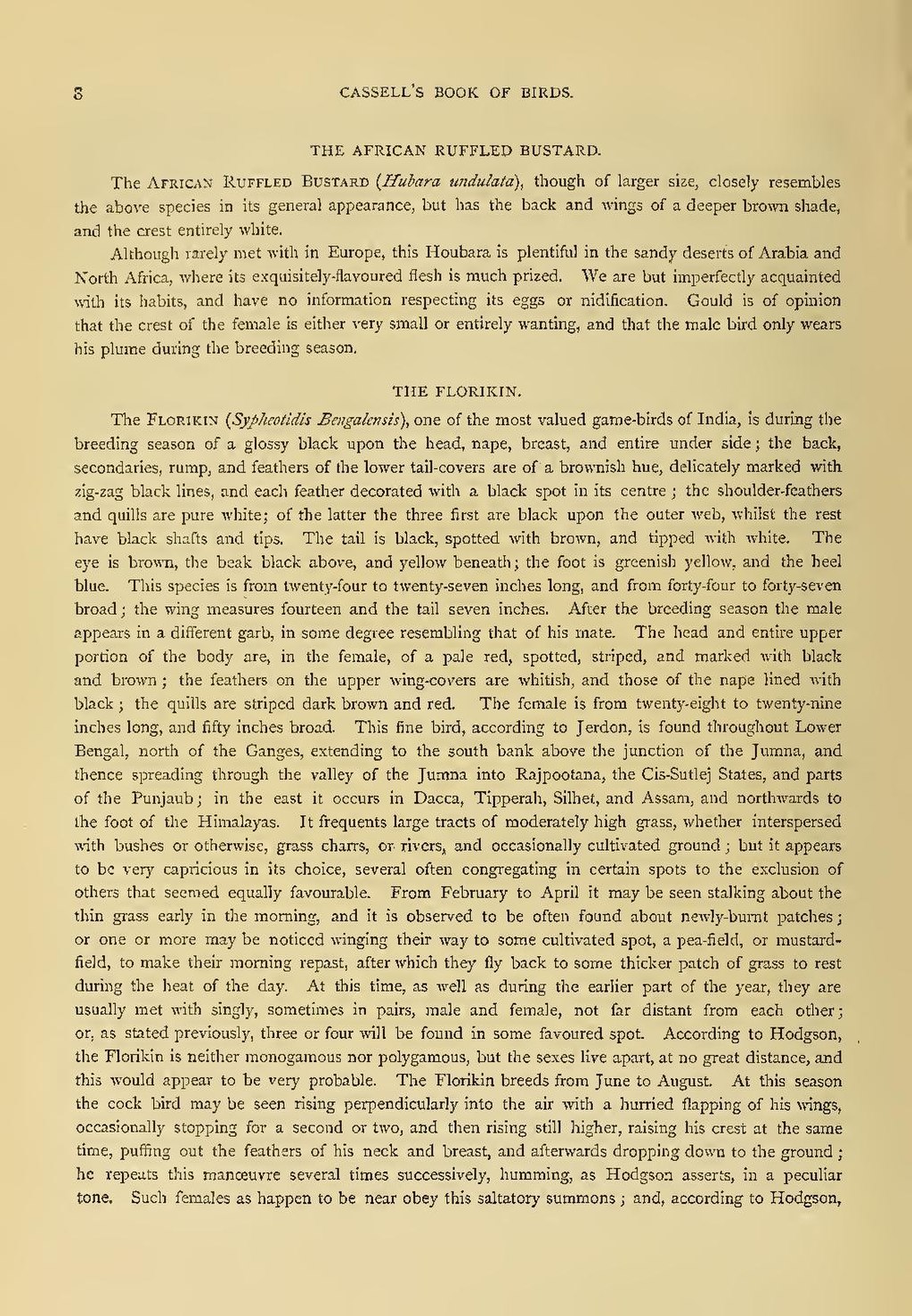THE AFRICAN RUFFLED BUSTARD.
The African Ruffled Bustard (Hubara undulata), though of larger size, closely resembles the above species in its general appearance, but has the back and wings of a deeper brown shade, and the crest entirely white.
Although rarely met with in Europe, this Houbara is plentiful in the sandy deserts of Arabia and North Africa, where its exquisitely-flavoured flesh is much prized. We are but imperfectly acquainted with its habits, and have no information respecting its eggs or nidification. Gould is of opinion that the crest of the female is either very small or entirely wanting, and that the male bird only wears his plume during the breeding season.
THE FLORIKIN.
The Florikin (Sypheotidis Bengalensis), one of the most valued game-birds of India, is during the breeding season of a glossy black upon the head, nape, breast, and entire under side; the back, secondaries, rump, and feathers of the lower tail-covers are of a brownish hue, delicately marked with zig-zag black lines, and each feather decorated with a black spot in its centre; the shoulder-feathers and quills are pure white; of the latter the three first are black upon the outer web, whilst the rest have black shafts and tips. The tail is black, spotted with brown, and tipped with white. The eye is brown, the beak black above, and yellow beneath; the foot is greenish yellow, and the heel blue. This species is from twenty-four to twenty-seven inches long, and from forty-four to forty-seven broad; the wing measures fourteen and the tail seven inches. After the breeding season the male appears in a different garb, in some degree resembling that of his mate. The head and entire upper portion of the body are, in the female, of a pale red, spotted, striped, and marked with black and brown; the feathers on the upper wing-covers are whitish, and those of the nape lined with black; the quills are striped dark brown and red. The female is from twenty-eight to twenty-nine inches long, and fifty inches broad. This fine bird, according to Jerdon, is found throughout Lower Bengal, north of the Ganges, extending to the south bank above the junction of the Jumna, and thence spreading through the valley of the Jumna into Rajpootana, the Cis-Sutlej States, and parts of the Punjaub; in the east it occurs in Dacca, Tipperah, Silhet, and Assam, and northwards to the foot of the Himalayas. It frequents large tracts of moderately high grass, whether interspersed with bushes or otherwise, grass charrs, or rivers, and occasionally cultivated ground; but it appears to be very capricious in its choice, several often congregating in certain spots to the exclusion of others that seemed equally favourable. From February to April it may be seen stalking about the thin grass early in the morning, and it is observed to be often found about newly-burnt patches; or one or more may be noticed winging their way to some cultivated spot, a pea-field, or mustard-field, to make their morning repast, after which they fly back to some thicker patch of grass to rest during the heat of the day. At this time, as well as during the earlier part of the year, they are usually met with singly, sometimes in pairs, male and female, not far distant from each other; or, as stated previously, three or four will be found in some favoured spot. According to Hodgson, the Florikin is neither monogamous nor polygamous, but the sexes live apart, at no great distance, and this would appear to be very probable. The Florikin breeds from June to August. At this season the cock bird may be seen rising perpendicularly into the air with a hurried flapping of his wings, occasionally stopping for a second or two, and then rising still higher, raising his crest at the same time, puffing out the feathers of his neck and breast, and afterwards dropping down to the ground; he repeats this manœuvre several times successively, humming, as Hodgson asserts, in a peculiar tone. Such females as happen to be near obey this saltatory summons; and, according to Hodgson,
